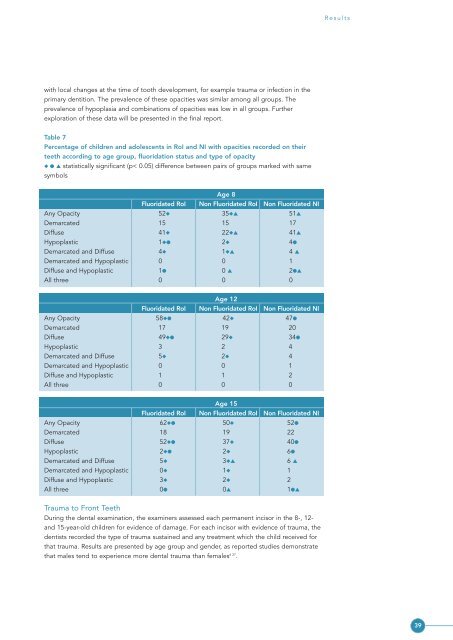Oral Health inside - Communities and Local Government
Oral Health inside - Communities and Local Government
Oral Health inside - Communities and Local Government
Create successful ePaper yourself
Turn your PDF publications into a flip-book with our unique Google optimized e-Paper software.
Resultswith local changes at the time of tooth development, for example trauma or infection in theprimary dentition. The prevalence of these opacities was similar among all groups. Theprevalence of hypoplasia <strong>and</strong> combinations of opacities was low in all groups. Furtherexploration of these data will be presented in the final report.Table 7Percentage of children <strong>and</strong> adolescents in RoI <strong>and</strong> NI with opacities recorded on theirteeth according to age group, fluoridation status <strong>and</strong> type of opacity◆ ● ▲ statistically significant (p< 0.05) difference between pairs of groups marked with samesymbolsAge 8Fluoridated RoI Non Fluoridated RoI Non Fluoridated NIAny Opacity 52◆ 35◆▲ 51▲Demarcated 15 15 17Diffuse 41◆ 22◆▲ 41▲Hypoplastic 1◆● 2◆ 4●Demarcated <strong>and</strong> Diffuse 4◆ 1◆▲ 4 ▲Demarcated <strong>and</strong> Hypoplastic 0 0 1Diffuse <strong>and</strong> Hypoplastic 1● 0 ▲ 2●▲All three 0 0 0Age 12Fluoridated RoI Non Fluoridated RoI Non Fluoridated NIAny Opacity 58◆● 42◆ 47●Demarcated 17 19 20Diffuse 49◆● 29◆ 34●Hypoplastic 3 2 4Demarcated <strong>and</strong> Diffuse 5◆ 2◆ 4Demarcated <strong>and</strong> Hypoplastic 0 0 1Diffuse <strong>and</strong> Hypoplastic 1 1 2All three 0 0 0Age 15Fluoridated RoI Non Fluoridated RoI Non Fluoridated NIAny Opacity 62◆● 50◆ 52●Demarcated 18 19 22Diffuse 52◆● 37◆ 40●Hypoplastic 2◆● 2◆ 6●Demarcated <strong>and</strong> Diffuse 5◆ 3◆▲ 6 ▲Demarcated <strong>and</strong> Hypoplastic 0◆ 1◆ 1Diffuse <strong>and</strong> Hypoplastic 3◆ 2◆ 2All three 0● 0▲ 1●▲Trauma to Front TeethDuring the dental examination, the examiners assessed each permanent incisor in the 8-, 12-<strong>and</strong> 15-year-old children for evidence of damage. For each incisor with evidence of trauma, thedentists recorded the type of trauma sustained <strong>and</strong> any treatment which the child received forthat trauma. Results are presented by age group <strong>and</strong> gender, as reported studies demonstratethat males tend to experience more dental trauma than females 6 27 .39
















